- Home
- Victor Hugo
The Hunchback of Notre-Dame Page 3
The Hunchback of Notre-Dame Read online
Page 3
Both Han of Iceland and Bug-Jargal drew heavily on Scott's expansive vision and his techniques of novel writing, adopting in particular his trademark use of couleur locale--local color--to bring the depiction of the historical period alive through attention to the picturesque. The 1823 preface to Han of Iceland playfully points out the care that went into reproducing the atmosphere of the tale's exotic location, down to the near-abusive use of the letters k, y, h, and w in the characters' names. In Bug-Jargal the island of Santo Domingo is also replete with an exoticism produced by vivid details, from the extremes of the tropical landscape to the mysterious language (a mixture of Spanish and Creole) spoken by the rebelling slaves. In a review of Scott's Quentin Durward that appeared in the July 1823 issue of La Muse francaise (a periodical Hugo helped found), Hugo openly lauded Scott's epic and colorful conception of the novel, hailing him as the catalyst of a literary renaissance and praising him for his all-encompassing exploration of the past, for the truth behind his fiction, and for his ability to diffuse a didactic message artfully. Yet Hugo stops short of extolling Scott's achievements as the apogee of the form; instead he uses his approbation of Scott as a spring-board to elaborate his own conception of the novel. Indeed, despite the critical failure of Han of Iceland, Hugo was in no way deterred from introducing and promoting his idea(1) of a yet non-existent form of the novel: "After the picturesque but prosaic novel of Walter Scott, there remains another novel to be created, more beautiful and still more complete. This novel is at once drama and epic, is picturesque but is also poetic, is real, yet also ideal, is true, but also grand--it will enshrine Walter Scott in Homer" (see, in "For Further Reading," Victor Hugo, Oeuvres completes, vol. 5, p. 131; translation mine).
It is this "new" novel that Hugo undertook to create with The Hunchback of Notre Dame, incorporating as organizing principles many of the artistic conceptions already presented relative to theater in his preface to Cromwell, such as man's inherent duality, the coexistence of antitheses in the universe, the tension between cyclical and progressive notions of time and history, and the essential and prophetic role of the poet-author. Hugo was also aware that this new novel belonged to a new time-both in terms of the political climate following the regime change of 1830, in which the period and the purpose of the Restoration were redefined as a constitutional monarchy came to power; and in terms of the literary climate, as literature was shifting more and more from the patronage model to a business model in which commercial concerns and the emergence of a new and more literate middle-class reading public had, for the first time, an impact on writers and their craft. Hugo's exclusion of several chapters from the first edition of The Hunchback can be understood in this context. Although Hugo claims in the "Author's Note Added to the Definitive Edition" (1832) that these three chapters--"Unpopularity" (book 4, chapter 6), "Abbas Beati Martini" (book 5, chapter 1), and "The One Will Kill the Other" (book 5, chapter 2)--were "lost" prior to the printing of the first edition, the truth is more likely that Hugo purposefully held them back to ensure his novel's commercial success, fearing that the latter two, which are strong in ideological content but do not advance the narrative, might compromise the rhythm of the story. Added incentive for waiting to include these chapters was the realization that the contract with Gosselin specified royalties for only two volumes, and that Gosselin--firm in his stance and already exasperated with Hugo's delays--would pay no more if Hugo went beyond the agreed-upon length of the manuscript. Retaining them for inclusion in a later edition (with a different publisher once his deal with Gosselin expired) granted Hugo the possibility of maximizing his profit.
Although such reasoning and negotiations may seem commonplace in today's world, Hugo's business savvy helped him avoid the financial and artistic dependence on the new reading public that many of his contemporaries faced. Indeed, the novel proved its worth in the 1830s with a number of successes-among them Stendhal's Le Rouge et le Noir (The Red and the Black, 1830) and Balzac's La Peau de chagrin (The Magic Skin, 1831)--increasingly validating the capacities of the form. As realism gradually emerged as the aesthetic and literary movement that would transform the novel into the principal literary genre, and as the serial publication of novels in newspapers spurred on the industrialization of literature, the novelist of the nineteenth century--well known or not-had to live by his or (much less often) her pen, and with this reality often came practical and artistic constraints. In Hugo's case, however, his careful management of the publication and republication of not only The Hunchback of Notre Dame but also his theatrical works and poetry resulted in a financial independence that ultimately allowed him to avoid the same kinds of concerns about content and style; he could write what he wanted, when he wanted. With regard to his fiction, which subsequently included Les Miserables (1862), Les Travailleurs de la mer (The Toilers of the Sea, 1866), L'Homme qui rit (The Man Who Laughs, 1869), and Quatrevingt-treize (Ninety-three, 1874), this freedom gave Hugo the space he needed to continue pursuing the concept of the novel outlined in his review of Quentin Durward, one in which core, universal truths are transmitted through an expansive exploration of the human condition.
While the majority of French novelists of the nineteenth century who are still read and studied today--Stendhal, Balzac, Gustave Flaubert, Emile Zola--focused their gaze inward on the workings of contemporary society and the ways the political turmoil of their recent past affected their present and the social behavior that defined it, and while the most celebrated French historical novelists, such as Alexandre Dumas--author of Les Trois Mousquetaires (The Three Musketeers, 1844) and Le Comte de Monte Cristo (The Count of Monte Cristo, 1844)--looked to the distant past as a way of distracting from the uncertainties of the here and now, Hugo wrote during the course of his career a decidedly different kind of novel. Hugo's novel viewed history--from long-ago medieval France in The Hunchback of Notre Dame, to the more recent post-Revolutionary and Restoration France in Les Miserables and The Toilers of the Sea, to the seemingly immaterial history of seventeenth-century England in The Man Who Laughs, to the haunting history of Revolutionary France in Ninety-three--as neither an explanation for the present nor an escape from it, but rather as a catalyst for grap pling with ideological and philosophical questions of the highest order relative to the passage of time itself and the nature of progress. Each of Hugo's novels tells and retells the same story of universal man and his struggles; in this larger context we can understand Hugo's surprising assertion, in an 1868 letter, that although he considered the historical novel a very good genre because Walter Scott had distinguished himself with it, he had "never written ... a historical novel" (Oeuvres completes, vol. 14, p. 1;254; translation mine). If, strictly speaking and by modern definition this declaration rings false, since all of Hugo's novels do meet the criteria to qualify as "historical," it is more significant that this disavowal--which was made while Hugo was in self-imposed exile in protest of the unfolding history of the Second Empire and its emperor, Napoleon III--underscores the complex understanding of and relationship to history that characterizes all of Hugo's work.
In The Hunchback of Notre Dame, Hugo's first real attempt to tell this universal story, this complexity finds its ideal expression in the symbol of the cathedral. Firmly planted in the historical moment of the crepuscule of the Middle Ages--the year 1482, as the subtitle to the French edition clearly specifies--the novel showcases one of the medieval period's great architectural achievements, the cathedral of Notre Dame, which is literally and figuratively at the center of all action (no wonder, then, that Hugo condemned the English translation of the title for shifting the focus from the cathedral to its bell ringer). This choice was undoubtedly affected by the zeal of the Romantic age for all things medieval. Ever since Chateaubriand's Genie du Christianisme (The Genius of Christianity, 1802), in which Chateaubriand sought to rehabilitate Gothic art and architecture as well as the Christian faith, there had been a renewed and even frenzied interest in this underappreciated period of history. H
ugo himself had jumped enthusiastically on the bandwagon with an 1825 article titled "Sur la destruction des monuments en France" (see endnote 28), in which he calls for an end to the demolition and mutilation of the monuments of the Middle Ages, pieces of a collective past in which history was inscribed. This idea of the monument as living history is developed and magnified in The Hunchback of Notre Dame, as the cathedral serves as the transitional marker both in art, between Roman and Gothic architecture, and in history, between the periods of the Middle Ages and the Renaissance. Yet this role of the monument as witness bearer, as "carved" history, is destined to be supplanted by the advent of a different kind of record, the printed page.
In "The One Will Kill the Other," one of the three chapters Hugo reintegrated into the definitive edition of the novel, the narrator seeks to elucidate the enigmatic words spoken by the Faustian priest Claude Frollo, who, during a mysterious visit from King Louis XI, makes, while looking alternately at an open book and the great cathedral, the melancholy assertion that "the book will kill the building" (p. 169). Frollo and the narrator, however, view the relationship between architecture and the written word in quite opposite ways. While Frollo, a high-ranking representative of the Church, laments the invention of the printing press in predicting that it will reduce the Church's theocratic stronghold, the narrator sees the printing press positively as a democratic invention that will serve to enlighten the masses. Implicit in this notion of inevitable enlightenment are the political dimensions of the more accessible printed word, a form of progress that will propel the masses out of the darkness and tyranny of the Middle Ages. The novel, in which the fictional trajectories and events are shadowed by the major political events of the year 1482--the final full year of the reign of the dying Louis XI--depicts in this way a world on the cusp of change. Using a technique opposite to that employed by most writers of the historical novel, in which the author strives to render time timeless, to transport the reader in a way that makes him unaware of the temporal abyss, Hugo, through his narrator, a man of 1830, repeatedly draws attention to the differences between these two eras, to the great divide between "then" and "now."
It is the representation of the masses--the people, who are at the height of their religious, judicial, social, economic, and political oppression--that best incarnates the essence of this transitional moment. First seen during Gringoire's mystery play at the Palace of Justice, the assembled throng (indistinct in its motivations and distinct in its restlessness) has a decidedly moblike quality. This menacing aspect is heightened through the development of the Parisian underworld of "vagrants" (thieves, beggars, vagabonds) in the "Court of Miracles." The cruelty, superstition, and barbaric ways that govern medieval Paris are mirrored and magnified in this city within the city, presided over by its own ruffian leaders. This group is characterized by its dynamic aspects, by a constant state of motion, yet motion in no way signifies movement in a forward direction or, figuratively, evolution; on the contrary, this group is equally defined by its inherent confusion and blindness. Just as its chosen "Pope of Fools," Quasimodo, is only "partially made," the vagrants are without any kind of ideological shape: They are ruled entirely by instincts of base survival and by their own self-interest. At no moment in the novel is this central lack of a guiding ideology more evident than in the scene in which the vagrants storm the cathedral to "save" Esmeralda, as this noble effort quickly degenerates into a frenzied desire to rebel and to pillage the cathedral of its treasures, and results in a staggering loss of lives. At the very heart of the vagrants' defeat is a chaos rooted in the breakdown of any common linguistic understanding ("There was an awful howl, intermingled with all languages, all dialects, all accents" [p. 410]). Indeed, in an ironic twist that highlights their inability to communicate, the vagrants and Quasimodo work at cross purposes, each believing the other to be the enemy. The vagrants' capacity to bring about change is dormant, and those not killed in the assault on Notre Dame are quickly brought down by the king's men.
Yet this effort itself, the bold and subversive action of attacking a church--that is to say, the house of God and, by divine right, that of the king--can be seen as a clear indication of things to come. For while the king succeeds in quelling and even erasing all traces of the vagrants' failed uprising (the narrator specifies that "Kings like Louis XI are careful to wash the pavement quickly after a massacre" (p. 479), in the larger framework of history another, more significant uprising is referenced, and the potential of this group to bring about change is deferred to a future moment. As Master Jacques Coppenole announces directly to the king, who comfortably oversees the brief mutiny from his apartment above the newly constructed Bastille prison, "The people's hour has not yet come" (p. 436). This direct allusion to the year 1789--when the French Revolution erupted violently with the storming of that same prison--reminds us that the people will in time become a (political) force great enough to bring down the monarchy. The march of time alone, however, is not enough to ensure progress. Written during the Restoration, a period that sought to turn time backward in wiping out all traces of the Revolution, First Republic, and Napoleonic Empire, the novel is ripe with unease relative to the notion of advancement. Through the numerous narrative interventions that refer the reader to recent or "present" history--including the July Revolution of 1830 (during which Hugo was at work on the novel)--the dangers of blind temporal progress, of the unfolding of one regime into the next, are underscored. While much attention has been given to the shift in Hugo's political views over the course of his lifetime, from royalist to republican, and of his political engagement (witnessed, for example, by his nineteen-year exile in reaction to the regression of Napoleon III's regime), progress for Hugo is, above all, ideological. In this way, the memorable dates of 1789, 1793, 1815, and 1830 (and later 1848 and 1870) are all steps on the way to a future sublime moment in which progress would be realized, a moment in which he unfailingly believed but that had not yet come to fruition.
In this conception of history, the roles played by destiny and fate are of capital importance. As the novel's epigraph informs us, the book is based upon the word ananke (the French rendition of the Greek word for "fate"), which had been "carved" on a wall of one of the towers and was "discovered" by the author during a visit to the cathedral. The word, however, as Hugo signals, has since "vanished," scraped away into nothingness by time or human effort. The story is thus placed from its outset under fate's implication of destruction and death, which is further reinforced during the course of the novel by the recurrent image of an innocent fly caught in a spider's toxic web. Both individual and collective destiny hang under the iron, immutable weight of anankee, as witnessed by the characters' trajectories and the social and moral stagnancy that asphyxiates the world of the novel. As we come to learn, it is Claude Frollo, who is at once archdeacon and occult scientist, torn by the impossibility of a different situation ("Oh, to love a woman! to be a priest! [p. 318]), who has traced these letters, but their significance applies to all of the novel's principal characters, themselves trapped in a web of impossible existence. Frollo loves Esmeralda, who despises him; Quasimodo also loves Esmeralda, who is horrified by the hunchback; and, in turn, Esmeralda loves Phoebus, who, morally bankrupt, is incapable of love. Maternal love and fraternal love are no less spared in this novel of unfulfilled passion: The suffering Paquette is reunited with Esmeralda, her long-lost daughter, only to have the girl immediately ripped away and put to death for her "crimes"; and Jehan Frollo, Claude's adored brother, who rebuffs his sibling's affection, meets his death at Quasimodo's hand during the assault on the cathedral, as Frollo himself will when his "adopted" son holds him responsible for Esmeralda's death. The oppressive hand of fate operates, by the novel's close, a mass liquidation of characters--Dom Frollo, Esmeralda, Paquette, Jehan Frollo, and Quasimodo are all dead--while, in a contrast that underscores the irony of destiny, those of mediocre moral substance survive: Phoebus gets out unscathed and marries, as planned, Fleur-de-Ly
s de Gondelaurier; and Gringoire, perhaps the wisest of all in the area of self-preservation, finds companionship with a goat preferable to the perils of human contact.
To translate this vision of impossible love in an impossible world, Hugo creates a new kind of character to populate his new novel or, at the very least, a different kind of character than the one put in place by his contemporaries. Void of the psychological depth and unity of composition that was increasingly valorized over the course of the nineteenth century, Hugo's characters, drawn from an archetypal model, are pure symbol. From Esmeralda, who is defined by her sublime state of physical and moral purity, to Paquette, on whom the primal maternal qualities of instinctive love and protection are transposed, to Phoebus, who, as his name implies, is brilliant on the exterior but lacks any true substance, they are larger-than-life representations. The characters of Claude Frollo and Quasimodo are larger than life as well, but they are complicated by the presence of a central duality through which universal man's struggle is figured. In the case of Frollo, in whom the opposing forces of good and evil engage in a fierce and debilitating combat as he struggles with his growing obsession with Esmeralda, this duality has no possibility for resolution or transcendence: Simultaneously attracted and repelled by the enchanting gypsy, Frollo is the spider and the fly, rigidly trapped in a tortured state between priest and demon. This internal turmoil manifests itself not only mentally, as Frollo loses all interest in his intellectual pursuits and in his much-loved brother, but physically, as Frollo passes during the course of the novel from human to beast to monster, as witnessed by his reaction to Esmeralda's hanging: "At the most awful moment a demoniac laugh--a laugh impossible to a mere man--broke from the livid lips of the priest" (p. 480). Just as occurs in the alchemy that Frollo investigates, he is literally transformed (changed from one form to another) by the novel's end, his body, as the narrator notes following Frollo's fall from the cathedral, found "without a trace of human shape" (p. 483).

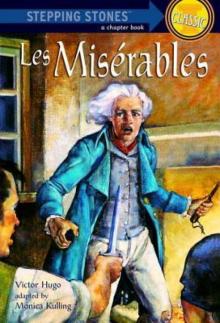 Les Miserables
Les Miserables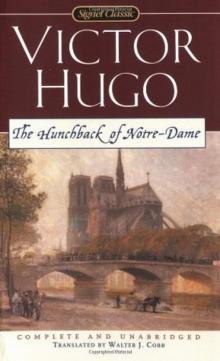 The Hunchback of Notre-Dame
The Hunchback of Notre-Dame The Man Who Laughs
The Man Who Laughs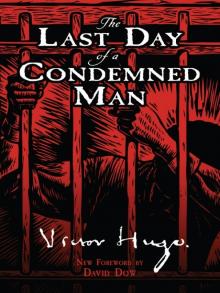 The Last Day of a Condemned Man
The Last Day of a Condemned Man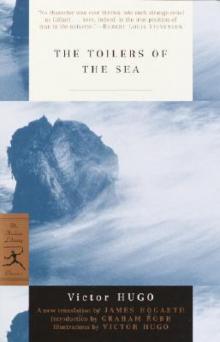 The Toilers of the Sea
The Toilers of the Sea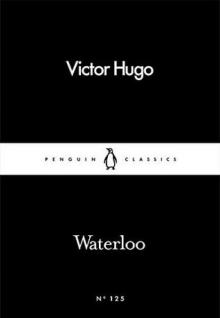 Waterloo
Waterloo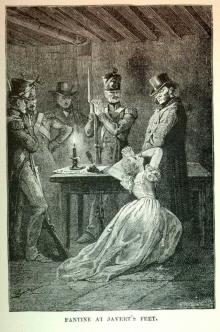 Les Misérables, v. 1/5: Fantine
Les Misérables, v. 1/5: Fantine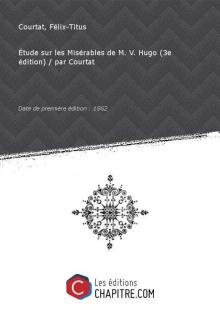 Les Misérables, v. 3/5: Marius
Les Misérables, v. 3/5: Marius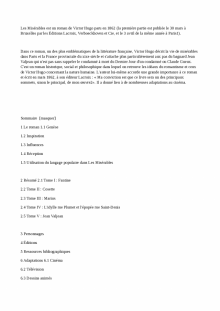 Les Misérables, v. 2/5: Cosette
Les Misérables, v. 2/5: Cosette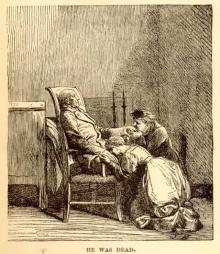 Les Misérables, v. 5/5: Jean Valjean
Les Misérables, v. 5/5: Jean Valjean Hunchback of Notre Dame (Barnes & Noble Classics Series)
Hunchback of Notre Dame (Barnes & Noble Classics Series)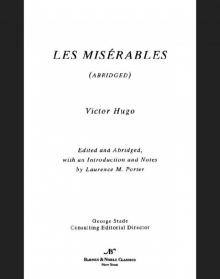 Les Miserables (abridged) (Barnes & Noble Classics Series)
Les Miserables (abridged) (Barnes & Noble Classics Series)